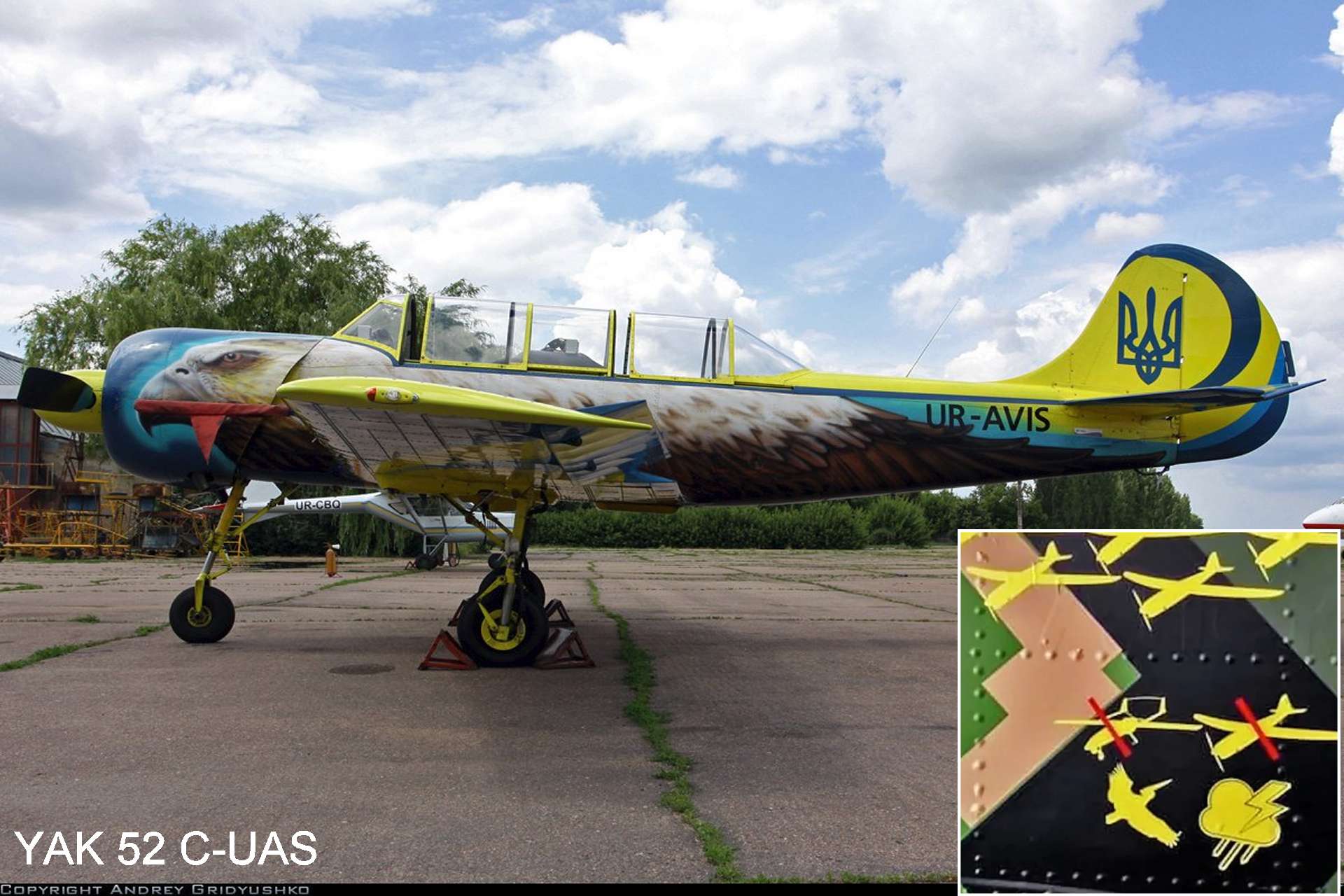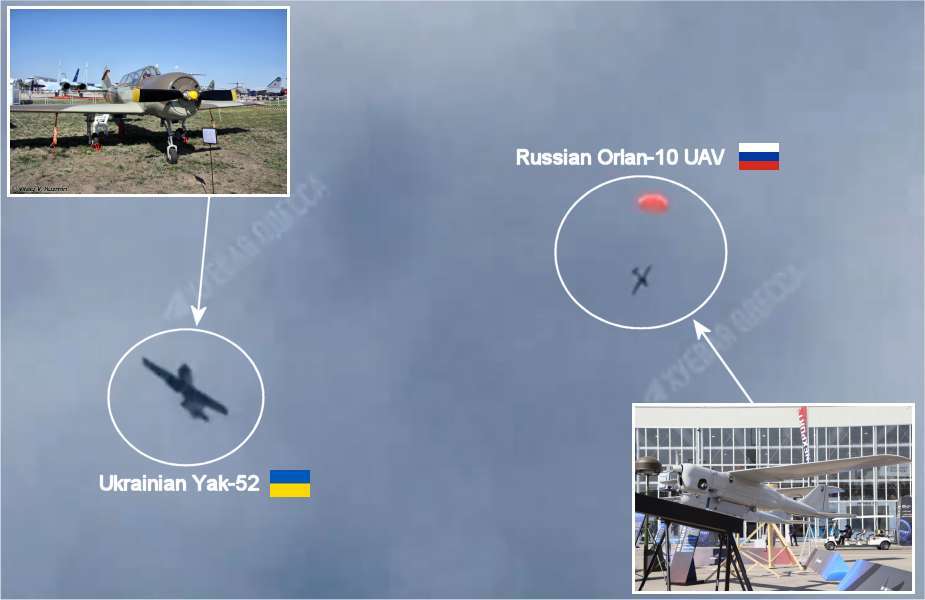Ukraine Uses Soviet-era Yak-52 Training Aircraft for Counter-UAS Operations Against Russia

{loadposition bannertop}
{loadposition sidebarpub}
A new video released on platform X has unveiled a Soviet-era Yak-52 training aircraft used by Ukrainian forces, featuring victory markings on its fuselage. These marks symbolize the aircraft’s growing and effective role as a drone hunter. Amid escalating Russian drone incursions, this inventive use of the Yak-52 showcases a flexible and responsive air defense strategy, adapted to the modern challenges of the conflict.Follow Army Recognition on Google News at this link
Ukrainian Soviet-era Yak-52 Training Aircraft used as C-UAS against Russian drones (Picture source: X/Twitter)
Recently published and then deleted photos on Facebook showed a Yak-52 in a hangar, painted in a digital camouflage scheme designed for low-altitude operations. These images confirm earlier reports about the use of these aircraft in air defense roles, mainly in southern Ukraine, away from the active front.
In one of the photos, a series of yellow marks below the cockpit can be seen, representing two ZALA 421-16E drones and six from the Orlan-10/30 series shot down by the aircraft. The ZALA and Orlan drones, used by Russia for surveillance and targeting, are equipped with electro-optical sensors and laser designators. Their extensive use in Ukraine has prompted Ukrainians to seek effective and low-cost solutions like the Yak-52 to counter this threat.
Interestingly, other markings represent an Iranian Mohajer-6 drone and another from the Orlan series, each crossed out with a red line. Symbolic images of a pelican and a storm cloud suggest that these drones may have been destroyed by natural circumstances rather than engaged directly, although the exact details remain unconfirmed.
These modified Yak-52s are operated by Ukraine’s Civil Air Patrol, a group comprised mainly of hobbyists and private aircraft owners. Facing the escalating drone threat, this unit has formed a Tactical Aviation Group aimed at neutralizing enemy UAVs, demonstrating innovative use of available resources.
The first documented use of a Yak-52 in this capacity was reported in April 2024 as revealed by an Army Recognition article dated April 29, 2024, when an aircraft with distinctive blue and yellow stripes on its wings was filmed maneuvering around an Orlan drone, just before the latter deployed its orange landing parachute. A more recent video also captured a Yak-52 in the same camouflage scheme engaging a drone, providing visual evidence of these aircraft in action.
These efforts are complemented by a range of air defense systems from mobile teams armed with machine guns to Patriot missile systems, illustrating Ukraine’s multifaceted response to the ongoing drone threat. The Yak-52, though unconventional, now plays a crucial role in the country’s air defense network, highlighting the adaptability and resilience of the Ukrainian armed forces in this prolonged conflict.
The Yak-52 is a military training aircraft designed by the Yakovlev design bureau and first introduced in 1979. It is a low-wing monoplane with tandem seating, powered by a 360 horsepower (268 kW) Vedeneyev M14P radial engine. With an empty weight of 1015 kg and a maximum takeoff weight of 1305 kg, it combines robustness and agility for training and aerobatic competitions.
This aircraft has a wingspan of 9.3 meters, a length of 7.7 meters, and a height of 2.7 meters. The Yak-52 can reach a maximum speed of 285 km/h at sea level and a cruising speed of 190 km/h at 1000 meters. Its ability to perform low-speed maneuvers, with a stall speed of 85-90 km/h, makes it particularly suited for operations such as low-altitude drone pursuit. With a service ceiling of 4000 meters and a climb rate of 7 m/s, it offers solid performance for a training and light patrol aircraft.
Moreover, the Yak-52 has been adapted in several versions, including modifications to increase fuel capacity and modernize its instruments for specific uses, such as the TW tail-dragger version which includes modern instruments and increased fuel capacity, making these aircraft more suited to contemporary needs, including UAV defense.
Currently, it is not explicitly known how Yak-52 planes manage to destroy drones. However, several theoretical modifications could be considered to adapt these aircraft for anti-drone missions. First, the Yak-52 could be equipped with simple electronic systems to jam or intercept communications between the drones and their operators. Another potential modification includes the addition of small armaments, such as light machine guns or unguided projectile launchers, which could be used to physically shoot down drones at close range.
Additionally, the Yak-52 could be used as a decoy to distract drones from more significant targets, thus allowing more capable ground defense systems to engage the drones more effectively. These adaptations would require careful engineering to ensure that the added weight and balancing of the aircraft do not compromise its flight capabilities. Although these methods are hypothetical, they illustrate the potential versatility of the Yak-52 in modern warfare scenarios where resources may be limited.
A Ukrainian Yak-52 training aircraft shoots down a Russian Orlan-10 drone. (Picture source: Vitaly V.Kuzmin / Army Recognition / Social Media)

{loadposition bannertop}
{loadposition sidebarpub}
A new video released on platform X has unveiled a Soviet-era Yak-52 training aircraft used by Ukrainian forces, featuring victory markings on its fuselage. These marks symbolize the aircraft’s growing and effective role as a drone hunter. Amid escalating Russian drone incursions, this inventive use of the Yak-52 showcases a flexible and responsive air defense strategy, adapted to the modern challenges of the conflict.
Follow Army Recognition on Google News at this link
Ukrainian Soviet-era Yak-52 Training Aircraft used as C-UAS against Russian drones (Picture source: X/Twitter)
Recently published and then deleted photos on Facebook showed a Yak-52 in a hangar, painted in a digital camouflage scheme designed for low-altitude operations. These images confirm earlier reports about the use of these aircraft in air defense roles, mainly in southern Ukraine, away from the active front.
In one of the photos, a series of yellow marks below the cockpit can be seen, representing two ZALA 421-16E drones and six from the Orlan-10/30 series shot down by the aircraft. The ZALA and Orlan drones, used by Russia for surveillance and targeting, are equipped with electro-optical sensors and laser designators. Their extensive use in Ukraine has prompted Ukrainians to seek effective and low-cost solutions like the Yak-52 to counter this threat.
Interestingly, other markings represent an Iranian Mohajer-6 drone and another from the Orlan series, each crossed out with a red line. Symbolic images of a pelican and a storm cloud suggest that these drones may have been destroyed by natural circumstances rather than engaged directly, although the exact details remain unconfirmed.
These modified Yak-52s are operated by Ukraine’s Civil Air Patrol, a group comprised mainly of hobbyists and private aircraft owners. Facing the escalating drone threat, this unit has formed a Tactical Aviation Group aimed at neutralizing enemy UAVs, demonstrating innovative use of available resources.
The first documented use of a Yak-52 in this capacity was reported in April 2024 as revealed by an Army Recognition article dated April 29, 2024, when an aircraft with distinctive blue and yellow stripes on its wings was filmed maneuvering around an Orlan drone, just before the latter deployed its orange landing parachute. A more recent video also captured a Yak-52 in the same camouflage scheme engaging a drone, providing visual evidence of these aircraft in action.
These efforts are complemented by a range of air defense systems from mobile teams armed with machine guns to Patriot missile systems, illustrating Ukraine’s multifaceted response to the ongoing drone threat. The Yak-52, though unconventional, now plays a crucial role in the country’s air defense network, highlighting the adaptability and resilience of the Ukrainian armed forces in this prolonged conflict.
The Yak-52 is a military training aircraft designed by the Yakovlev design bureau and first introduced in 1979. It is a low-wing monoplane with tandem seating, powered by a 360 horsepower (268 kW) Vedeneyev M14P radial engine. With an empty weight of 1015 kg and a maximum takeoff weight of 1305 kg, it combines robustness and agility for training and aerobatic competitions.
This aircraft has a wingspan of 9.3 meters, a length of 7.7 meters, and a height of 2.7 meters. The Yak-52 can reach a maximum speed of 285 km/h at sea level and a cruising speed of 190 km/h at 1000 meters. Its ability to perform low-speed maneuvers, with a stall speed of 85-90 km/h, makes it particularly suited for operations such as low-altitude drone pursuit. With a service ceiling of 4000 meters and a climb rate of 7 m/s, it offers solid performance for a training and light patrol aircraft.
Moreover, the Yak-52 has been adapted in several versions, including modifications to increase fuel capacity and modernize its instruments for specific uses, such as the TW tail-dragger version which includes modern instruments and increased fuel capacity, making these aircraft more suited to contemporary needs, including UAV defense.
Currently, it is not explicitly known how Yak-52 planes manage to destroy drones. However, several theoretical modifications could be considered to adapt these aircraft for anti-drone missions. First, the Yak-52 could be equipped with simple electronic systems to jam or intercept communications between the drones and their operators. Another potential modification includes the addition of small armaments, such as light machine guns or unguided projectile launchers, which could be used to physically shoot down drones at close range.
Additionally, the Yak-52 could be used as a decoy to distract drones from more significant targets, thus allowing more capable ground defense systems to engage the drones more effectively. These adaptations would require careful engineering to ensure that the added weight and balancing of the aircraft do not compromise its flight capabilities. Although these methods are hypothetical, they illustrate the potential versatility of the Yak-52 in modern warfare scenarios where resources may be limited.

A Ukrainian Yak-52 training aircraft shoots down a Russian Orlan-10 drone. (Picture source: Vitaly V.Kuzmin / Army Recognition / Social Media)






